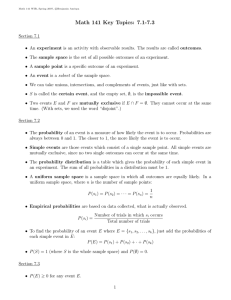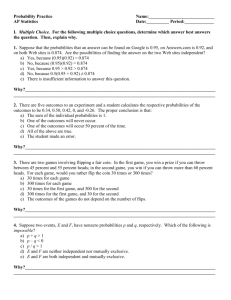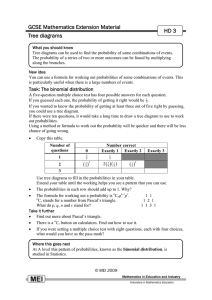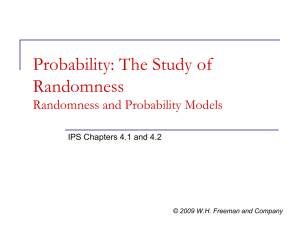§7.2 Definition of Probability
advertisement
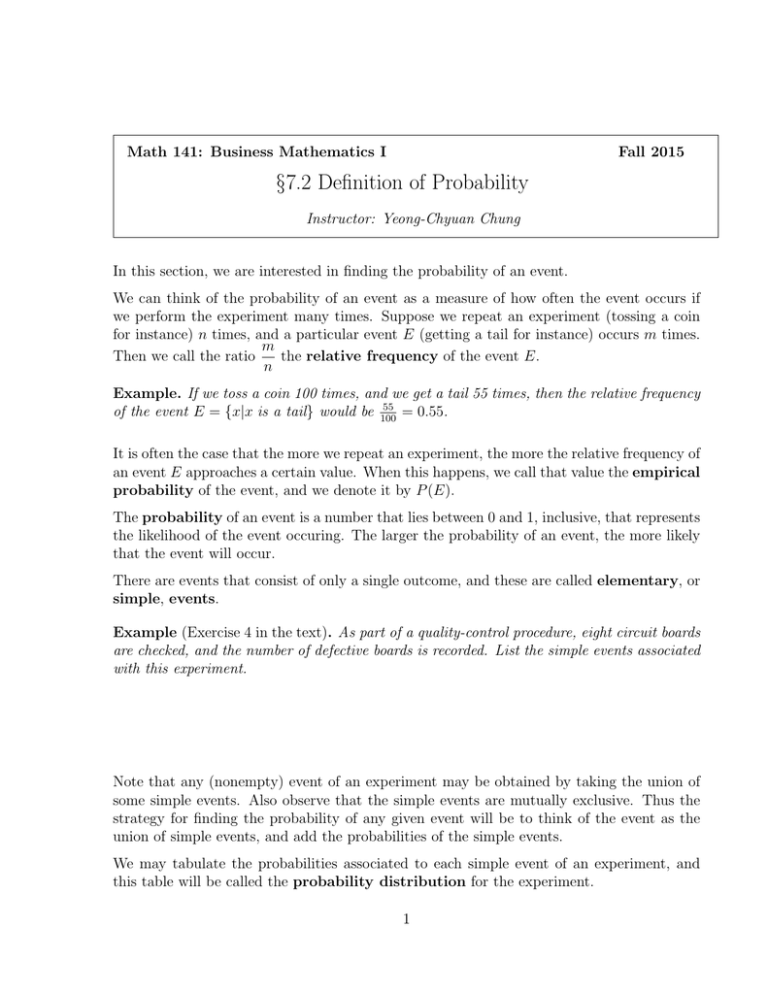
Math 141: Business Mathematics I
Fall 2015
§7.2 Definition of Probability
Instructor: Yeong-Chyuan Chung
In this section, we are interested in finding the probability of an event.
We can think of the probability of an event as a measure of how often the event occurs if
we perform the experiment many times. Suppose we repeat an experiment (tossing a coin
for instance) n times, and a particular event E (getting a tail for instance) occurs m times.
m
the relative frequency of the event E.
Then we call the ratio
n
Example. If we toss a coin 100 times, and we get a tail 55 times, then the relative frequency
55
of the event E = {x|x is a tail} would be 100
= 0.55.
It is often the case that the more we repeat an experiment, the more the relative frequency of
an event E approaches a certain value. When this happens, we call that value the empirical
probability of the event, and we denote it by P (E).
The probability of an event is a number that lies between 0 and 1, inclusive, that represents
the likelihood of the event occuring. The larger the probability of an event, the more likely
that the event will occur.
There are events that consist of only a single outcome, and these are called elementary, or
simple, events.
Example (Exercise 4 in the text). As part of a quality-control procedure, eight circuit boards
are checked, and the number of defective boards is recorded. List the simple events associated
with this experiment.
Note that any (nonempty) event of an experiment may be obtained by taking the union of
some simple events. Also observe that the simple events are mutually exclusive. Thus the
strategy for finding the probability of any given event will be to think of the event as the
union of simple events, and add the probabilities of the simple events.
We may tabulate the probabilities associated to each simple event of an experiment, and
this table will be called the probability distribution for the experiment.
1
§7.2 Definition of Probability
2
Example (Exercise 10a in the text). In a survey of 26,612 Parade.com visitors, the following
question was asked: How do workers get ahead? The results of the survey are as follows:
Answer
Respondents
Internal politics Hard work
13,572
7,185
Initiative Creativity
4,790
1,065
Find the probability distribution associated with these data.
What is the probability that a participant in the survey selected at random answered that one
gets ahead at work through hard work?
The function P , which assigns a probability to each simple event, is called a probability
function.
Suppose that the sample is S = {s1 , . . . , sn }, so the possible outcomes are s1 , . . . , sn . Then
the simple events are {s1 }, {s2 }, . . . , {sn }. We will write P (si ) (instead of P ({si })) for
the probability of the simple event {si }. Then the probability function has the following
properties:
• 0 ≤ P (si ) ≤ 1 for each simple event {si }.
• P (s1 ) + P (s2 ) + · · · + P (sn ) = 1.
• P ({si } ∪ {sj }) = P (si ) + P (sj ) for any pair of distinct simple events {si }, {sj }.
In words, the three properties above can be stated as:
• The probability of each simple event must be between 0 and 1, inclusive.
• The sum of the probabilities of all the simple events is 1. (This is because the union
of all the simple events is the whole sample space.)
• The probability of the union of two distinct simple events is given by the sum of
their individual probabilities. (This is because two distinct simple events are mutually
exclusive.)
Sample spaces in which the outcomes are equally likely are called uniform sample spaces.
It is relatively easy to assign probabilities to the simple events in such sample spaces because
of the second property of the probability function.
If S = {s1 , . . . , sn } is a uniform sample space, then P (s1 ) = P (s2 ) = · · · = P (sn ) = n1 .
§7.2 Definition of Probability
3
The general procedure of finding the probability of an event E is as follows:
1. Determine the sample space S.
2. Assign probabilities to each simple event {si }.
3. If the event E is {s1 , . . . , sn }, then P (E) = P (s1 ) + P (s2 ) + · · · + P (sn ). If the event
E is the empty set, then P (E) = 0.
In other words, once the probabilities of the simple events are known, they can be used to
find the probability of any other event.
WARNING: The last step where we simply add probabilities can only be applied when every
event on the right-hand side is a simple event.
Example (Exercise 36 in the text). Let S = {s1 , s2 , s3 , s4 , s5 , s6 } be the sample space associated with an experiment having the probability distribution:
Outcome
Probability
s1
s2
s3
s4
s5
s6
1
2
1
4
1
12
1
6
1
3
1
12
Find the probability of each of the events A = {s1 , s3 }, B = {s2 , s4 , s5 , s6 }, and C = S.
Example (Exercise 48 in the text). In a poll conducted by the Pew Research Center in a
certain year, 2000 adults ages 18 years old and older were asked how frequently they are in
touch with their parents by phone. The results of the poll are as follows:
Answer
Respondents (%)
Monthly Weekly Daily
11
47
32
Don’t know
2
Less
8
If a person who participated in the poll is selected at random, what is the probability that the
person said he or she kept in touch with his or her parents:
(a) Once a week?
(b) At least once a week?
